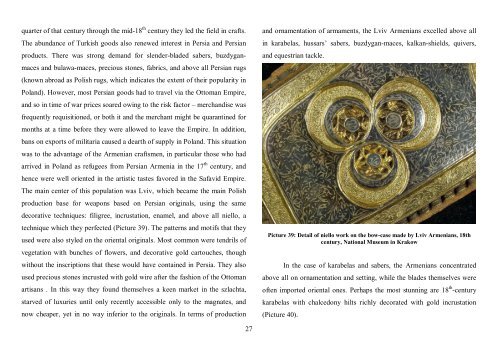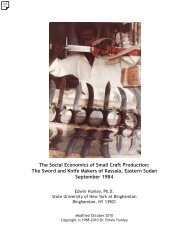Eastern Influences on Polish Arms (pdf) - Medieval Sword
Eastern Influences on Polish Arms (pdf) - Medieval Sword
Eastern Influences on Polish Arms (pdf) - Medieval Sword
Create successful ePaper yourself
Turn your PDF publications into a flip-book with our unique Google optimized e-Paper software.
quarter of that century through the mid-18 th century they led the field in crafts.<br />
The abundance of Turkish goods also renewed interest in Persia and Persian<br />
products. There was str<strong>on</strong>g demand for slender-bladed sabers, buzdygan-<br />
maces and bulawa-maces, precious st<strong>on</strong>es, fabrics, and above all Persian rugs<br />
(known abroad as <strong>Polish</strong> rugs, which indicates the extent of their popularity in<br />
Poland). However, most Persian goods had to travel via the Ottoman Empire,<br />
and so in time of war prices soared owing to the risk factor – merchandise was<br />
frequently requisiti<strong>on</strong>ed, or both it and the merchant might be quarantined for<br />
m<strong>on</strong>ths at a time before they were allowed to leave the Empire. In additi<strong>on</strong>,<br />
bans <strong>on</strong> exports of militaria caused a dearth of supply in Poland. This situati<strong>on</strong><br />
was to the advantage of the Armenian craftsmen, in particular those who had<br />
arrived in Poland as refugees from Persian Armenia in the 17 th century, and<br />
hence were well oriented in the artistic tastes favored in the Safavid Empire.<br />
The main center of this populati<strong>on</strong> was Lviv, which became the main <strong>Polish</strong><br />
producti<strong>on</strong> base for weap<strong>on</strong>s based <strong>on</strong> Persian originals, using the same<br />
decorative techniques: filigree, incrustati<strong>on</strong>, enamel, and above all niello, a<br />
technique which they perfected (Picture 39). The patterns and motifs that they<br />
used were also styled <strong>on</strong> the oriental originals. Most comm<strong>on</strong> were tendrils of<br />
vegetati<strong>on</strong> with bunches of flowers, and decorative gold cartouches, though<br />
without the inscripti<strong>on</strong>s that these would have c<strong>on</strong>tained in Persia. They also<br />
used precious st<strong>on</strong>es incrusted with gold wire after the fashi<strong>on</strong> of the Ottoman<br />
artisans . In this way they found themselves a keen market in the szlachta,<br />
starved of luxuries until <strong>on</strong>ly recently accessible <strong>on</strong>ly to the magnates, and<br />
now cheaper, yet in no way inferior to the originals. In terms of producti<strong>on</strong><br />
27<br />
and ornamentati<strong>on</strong> of armaments, the Lviv Armenians excelled above all<br />
in karabelas, hussars’ sabers, buzdygan-maces, kalkan-shields, quivers,<br />
and equestrian tackle.<br />
Picture 39: Detail of niello work <strong>on</strong> the bow-case made by Lviv Armenians, 18th<br />
century, Nati<strong>on</strong>al Museum in Krakow<br />
In the case of karabelas and sabers, the Armenians c<strong>on</strong>centrated<br />
above all <strong>on</strong> ornamentati<strong>on</strong> and setting, while the blades themselves were<br />
often imported oriental <strong>on</strong>es. Perhaps the most stunning are 18 th -century<br />
karabelas with chalced<strong>on</strong>y hilts richly decorated with gold incrustati<strong>on</strong><br />
(Picture 40).



